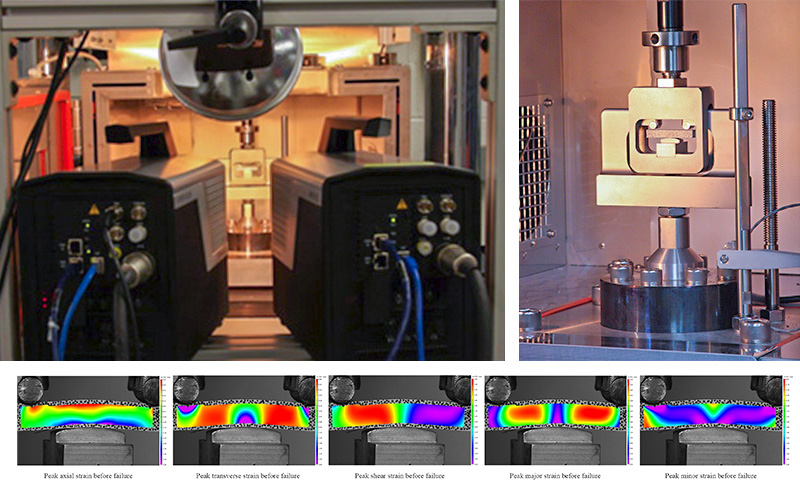Professor Andrew Makeev and Research Engineer Brian Shonkwiler at the University of Texas Arlington Mechanical and Aerospace Engineering department operate a dynamic DIC testing laboratory. Together they conduct a variety of DIC tests ranging from quasi-static to extremely dynamic testing. In this particular example, UTA are utilizing the VIC-3D UHS-HPVX2 system to measure dynamic properties of a glass/epoxy material. The purpose of this Short Beam Shear test is to measure multiple material properties such as shear & axial modulus, and shear strength.
The turnkey system from Correlated Solutions includes two Shimadzu HPV-X2 ultra high-speed video cameras which are conveniently controlled with Correlated Solutions’ software VIC-Snap UHS. The images are acquired during the event, downloaded, and then post-processed with VIC-3D. The frame rate for this test was 666,667 FPS with a 200 nano exposure. The specimen was speckled using a permanent marker, and an extremely bright stroboscope was used to illuminate the specimen. The impact velocity was 10 m/s, and the specimen reached approximately 3.5% shear strain at failure, which took approximately 100 microseconds.
As Mr. Shonkwiler states, “The purpose of the impact test is to determine how the dynamic characteristics of the material properties differ from the static properties. The importance of using the VIC-3D system is the fact that there are steep strain gradients on the face of the specimen. We would never get the strain information we need using a strain gage.
DIC is enabling a more efficient means of finding material properties of materials. The standard test methods require many different types of tests that often use relatively large specimens. The short beam shear specimen is small, which allows one to make hundreds of specimens from a small panel. Additionally, since composites are not isotropic, the material properties can vary from the 1–2, 1–3, and 2–3 planes. We can get properties from all three planes by simply cutting the short beam specimen from the panel at a different orientation or by flipping it, and so DIC has been an essential tool for our research as it helps us understand the behavior of these complex materials in great detail due to the full-field nature of the technology. This technology will be useful for any industry which needs composite materials properties.”
Contact us for more information on ultra high-speed 3D-DIC.
Learn more online at Correlated Solutions…
